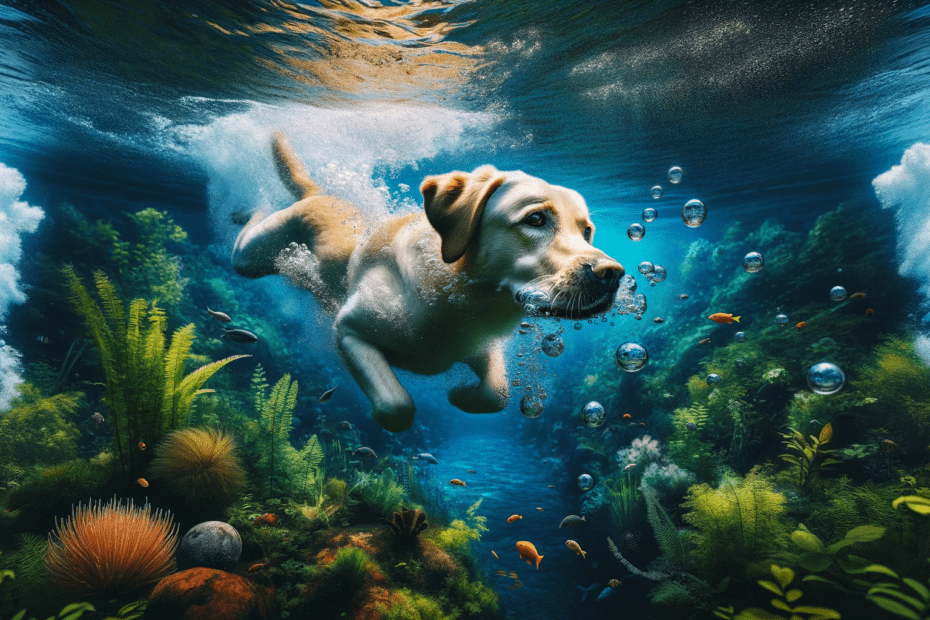Understanding the respiratory capabilities of dogs is crucial for their well-being and safety, particularly in water-related activities. This article explores the intricate anatomy of a canine lung and factors that influence a dog’s breath-holding abilities.
We delve into the average breath-holding times for different dog breeds and investigate the potential impact of training on enhancing these abilities. Additionally, surprising facts about dogs and water, as well as safety precautions for dogs engaging in water activities, are discussed.
Key Takeaways
- Dog respiration is a complex process involving the nasal passages, trachea, bronchi, and lungs.
- Factors such as fitness, breed, and genetics can affect a dog’s ability to hold their breath.
- Different dog breeds have varying breath-holding capabilities due to factors like lung capacity and body size.
- Training, gradual exposure to water, and breath control exercises can potentially increase a dog’s breath-holding time.
Understanding Dog Respiration
Dog respiration is a complex physiological process that allows dogs to inhale and exhale air through their respiratory system. Understanding the intricacies of dog respiration is crucial for veterinarians and pet owners alike. The canine lung anatomy plays a significant role in this process.
The respiratory system of a dog consists of several components, including the nasal passages, trachea, bronchi, and lungs. The nose acts as the primary entry point for air, where it is filtered, moistened, and warmed. From there, the air travels down the trachea, a tube that connects the nose to the lungs. The trachea branches into two main bronchi, which further divide into smaller bronchioles, eventually leading to the alveoli.
The alveoli are tiny air sacs within the lungs where gas exchange occurs. Oxygen from the inhaled air diffuses into the bloodstream, while carbon dioxide, a waste product, is expelled during exhalation. The lungs of dogs are elastic, allowing them to expand and contract as the dog breathes. This elasticity facilitates the intake of oxygen and the removal of carbon dioxide.
Understanding the canine lung anatomy provides insights into the efficiency of dog respiration. This knowledge is valuable in diagnosing and treating respiratory conditions that may affect a dog’s overall health and well-being.
The Anatomy of a Canine Lung
How efficiently do canine lungs facilitate gas exchange? To understand this, let’s delve into the intricate anatomy of a canine lung and the respiration process.
The structure of a canine lung is well-designed to optimize gas exchange. It consists of a network of airways that progressively branch out into smaller tubes called bronchioles, which eventually terminate in tiny air sacs called alveoli. The alveoli are the primary sites of gas exchange, where oxygen from the inhaled air diffuses into the bloodstream, while carbon dioxide, a waste product of metabolism, is released from the bloodstream into the alveoli to be exhaled.
The canine lung’s structure allows for a vast surface area for gas exchange to occur. The alveoli are surrounded by a dense network of capillaries, ensuring close proximity between air and blood. This proximity facilitates the efficient diffusion of gases across the thin walls of the alveoli and capillaries.
The respiration process in dogs involves inhalation and exhalation. During inhalation, the diaphragm contracts, causing it to move downward and expand the chest cavity. This expansion creates negative pressure, drawing air into the lungs. Exhalation, on the other hand, occurs when the diaphragm relaxes, allowing the chest cavity to return to its original size and expel air from the lungs.
Factors Affecting Breath Holding in Dogs
Several factors can influence a dog’s ability to hold their breath. One important factor is their level of breath control. Dogs with better breath control are generally able to hold their breath for longer periods of time. This is because they have a higher level of respiratory muscle control, allowing them to regulate their breathing more effectively.
Another factor that affects a dog’s breath holding ability is their level of fitness and physical conditioning. Dogs that are in better shape tend to have stronger respiratory muscles, which allows them to hold their breath for longer periods of time. Regular exercise and physical activity can help improve a dog’s respiratory fitness and enhance their breath control.
Furthermore, certain breeds of dogs may have a natural inclination towards holding their breath for longer periods. For example, dogs that are bred for underwater exploration, such as water rescue dogs or diving dogs, may have a genetic predisposition for better breath control and the ability to hold their breath for extended periods underwater.
Average Breath-Holding Time for Different Dog Breeds
Variations in breath-holding capabilities exist among different dog breeds, highlighting the influence of genetics and physiological factors.
Understanding the average breath-holding time for various breeds is crucial for assessing their potential in activities such as underwater search and rescue operations or competitive diving.
Factors such as lung capacity, body size, and overall health contribute to these variations, making it imperative to consider breed-specific characteristics when evaluating breath-holding abilities in dogs.
Breed Breath-Holding Variations
The average breath-holding time for different dog breeds can vary significantly. While there are no official canine breath holding records, researchers have observed breed-specific breath holding techniques that contribute to these variations.
For instance, brachycephalic breeds such as Bulldogs and Pugs have shorter snouts, which can make it more challenging for them to hold their breath for extended periods.
On the other hand, sighthounds like Greyhounds and Whippets have elongated bodies and efficient respiratory systems that allow them to hold their breath for longer durations.
Additionally, water-loving breeds like Retrievers and Newfoundlands have been observed to have above-average breath-holding abilities, likely due to their natural affinity for swimming and diving.
Understanding these breed-specific variations in breath-holding abilities can provide valuable insights into the physiological adaptations of different dog breeds.
Factors Affecting Breath-Holding
Factors affecting breath-holding in dogs can vary depending on the breed. While some breeds may naturally possess better breath-holding abilities, other factors such as age, health, and training can also influence a dog’s ability to hold its breath.
Additionally, the techniques used by dogs to hold their breath can play a role in their performance. Some dogs are trained to hold their breath by closing their nostrils, while others may use a technique called laryngeal sealing, where they close off the entrance to their windpipe. These techniques can be honed and refined through training, allowing dogs to improve their breath-holding abilities over time.
Breath-holding competitions, where dogs showcase their breath-holding skills, provide a platform for evaluating and comparing the breath-holding capabilities of different dog breeds.
Can Training Increase a Dog’s Breath-Holding Time
Training can potentially increase a dog’s breath-holding time. Through the use of specific training techniques and safety precautions, dogs can be conditioned to hold their breath for longer periods of time.
To increase a dog’s breath-holding time, trainers can implement techniques such as gradual exposure to water and breath control exercises. Gradual exposure involves acclimating the dog to water by starting with shallow pools and gradually increasing the depth over time. This helps the dog build confidence and tolerance for underwater situations. Breath control exercises involve teaching the dog to hold their breath on command, gradually increasing the duration as they become more comfortable.
However, it is crucial to prioritize safety when training dogs to hold their breath. Trainers should always closely monitor the dog’s behavior and avoid forcing them beyond their comfort zone. It is recommended to work with a professional trainer who is experienced in water training and understands the dog’s specific breed characteristics.
It is important to note that while training can improve a dog’s breath-holding ability, individual differences among dogs may limit the extent of improvement. Additionally, not all dogs are physically suited for extended breath-holding due to anatomical differences or health conditions. Therefore, it is essential to consider each dog’s unique capabilities and limitations when engaging in breath-holding training.
Surprising Facts About Dogs and Water
One surprising fact about dogs and water is that they have an innate ability to sense and navigate underwater obstacles. Canine swimming skills are a result of their evolutionary adaptation to aquatic environments. Dogs have a natural instinct for swimming and can effortlessly navigate through water. This ability is attributed to their streamlined bodies, webbed paws, and strong hind limbs, which allow them to propel themselves through the water with ease.
Additionally, dogs possess a keen sense of spatial awareness, enabling them to detect obstacles and adjust their movements accordingly. They can accurately judge distances and depths, making them adept at avoiding underwater hazards such as rocks, branches, or other submerged objects. This impressive skill set makes dogs highly efficient swimmers and ensures their safety when in or around water.
To ensure water safety for dogs, it is essential for owners to provide proper supervision and training. Although dogs have natural swimming abilities, they may still face dangers such as strong currents or exhaustion. Owners should consider providing life jackets for dogs, especially during activities such as boating or swimming in unfamiliar waters. Additionally, teaching dogs basic water safety commands, such as ‘come’ or ‘stay,’ can help prevent accidents and ensure a positive water experience for both the dog and the owner.
Breath-Holding Abilities in Working Dogs
Breath-holding abilities in working dogs are a subject of interest due to their potential impact on various tasks they are trained to perform. Factors such as breed, size, and physical fitness can influence a dog’s ability to hold its breath.
Additionally, training techniques focused on building endurance can further enhance a working dog’s breath-holding capabilities, allowing them to excel in tasks that require underwater or prolonged breath-holding skills.
Can Working Dogs Hold Breath
Working dogs possess remarkable breath-holding capabilities, showcasing their exceptional endurance and resilience in various demanding tasks. While the exact duration of breath-holding in working dogs may vary depending on factors such as breed, size, and overall fitness, these animals have been observed to hold their breath for extended periods.
This ability is particularly advantageous in situations where dogs are required to dive underwater or work in environments with limited oxygen supply. For example, search and rescue dogs often need to navigate through submerged areas during water rescues, relying on their breath-holding abilities to perform their duties effectively.
Additionally, working dogs employed in tasks such as sniffing out explosives or drugs may need to hold their breath to avoid inhaling potentially harmful substances.
The breath-holding abilities of working dogs make them valuable assets in various challenging scenarios, highlighting their exceptional physiological adaptations.
Factors Affecting Breath-Holding
Factors influencing the duration of breath-holding in working dogs include various physiological and environmental considerations. Canine breath holding techniques can vary depending on the specific task or training involved.
Working dogs, such as search and rescue dogs or military dogs, may be trained to hold their breath for short periods of time while submerged in water during water rescues or diving operations. However, it is important to note that the ability to hold their breath for extended periods is limited in dogs compared to humans.
Additionally, certain medical conditions affecting breath holding, such as respiratory diseases or heart conditions, may further impact a dog’s ability to hold their breath.
Understanding these factors is crucial for the effective training and utilization of working dogs in various scenarios.
Training Techniques for Endurance
To enhance the endurance of working dogs in breath-holding tasks, specific training techniques can be implemented.
Endurance training plays a crucial role in improving a dog’s ability to hold their breath for extended periods. One method involves gradually increasing the duration of breath-holding exercises over time. This gradual progression helps the dog build up their lung capacity and strengthen their respiratory muscles.
Additionally, breath control techniques can be taught to the dogs to maximize their breath-holding abilities. These techniques include diaphragmatic breathing, which involves deep inhaling and exhaling, as well as breath-holding exercises that simulate real-life scenarios.
Training sessions should be structured and repetitive to ensure consistent progress. By implementing these endurance training and breath control techniques, working dogs can develop impressive breath-holding abilities, enabling them to perform their tasks efficiently and effectively.
Safety Precautions for Dogs in Water Activities
When engaging dogs in water activities, it is important to implement safety precautions. Water safety is crucial to ensure the well-being of our canine companions during these activities. One essential safety measure is the use of dog flotation devices. These devices are designed to provide buoyancy and keep dogs afloat in the water, minimizing the risk of drowning or fatigue.
Dog flotation devices, also known as life jackets, are specially designed to fit the anatomy of dogs. They typically feature adjustable straps and a handle on the top to facilitate rescue if needed. The flotation material used in these devices is lightweight and buoyant, allowing dogs to maintain a natural swimming position while also providing support to keep their heads above water.
When choosing a dog flotation device, it is important to consider the size and weight of the dog. The device should fit snugly without restricting movement or causing discomfort. Proper fitting will ensure that the flotation device stays securely in place, even during vigorous activities.
Additionally, it is important to introduce dogs to the flotation device gradually. This can be done by allowing them to wear it on land before introducing them to the water. Familiarizing dogs with the device will help them feel more comfortable and confident when engaging in water activities.
Frequently Asked Questions
Can Dogs Hold Their Breath for Longer Periods of Time Compared to Humans?
Dogs possess a remarkable ability to hold their breath for longer periods compared to humans. This can be attributed to several factors, including their unique lung capacity and physiological adaptations.
Dogs have a greater lung volume relative to their body size, allowing for increased oxygen storage. Additionally, dogs have adaptations in their respiratory system, such as a higher concentration of oxygen-carrying red blood cells, which enable them to efficiently utilize oxygen and prolong breath-holding.
These adaptations contribute to dogs’ ability to hold their breath for extended durations.
Do Smaller Dog Breeds Have Shorter Breath-Holding Times Than Larger Breeds?
Smaller dog breeds generally have shorter breath-holding times compared to larger breeds. This is primarily due to differences in lung capacity and metabolic rates.
Smaller dogs have smaller lungs, which limits their ability to hold their breath for extended periods. Additionally, smaller breeds typically have higher metabolic rates, requiring more frequent respiration.
However, it is important to note that individual variations exist within each breed, and factors such as training and fitness level can also influence a dog’s breath-holding ability.
Are There Any Health Conditions That Can Affect a Dog’s Ability to Hold Its Breath?
Various health conditions can affect a dog’s ability to hold its breath.
Respiratory diseases, such as chronic bronchitis or pneumonia, can impair lung function and reduce the dog’s capacity to hold its breath.
Additionally, conditions like laryngeal paralysis or tracheal collapse can obstruct the airway and make it difficult for the dog to hold its breath for extended periods.
Understanding these health conditions and their impact on a dog’s breath-holding abilities is crucial for diagnosing and managing respiratory issues in dogs.
Can a Dog’s Age Affect Its Breath-Holding Abilities?
A dog’s breed can potentially affect its breath-holding abilities. Certain breeds, such as the Labrador Retriever, have been bred for their swimming abilities and have a natural instinct to hold their breath underwater.
On the other hand, brachycephalic breeds, like Bulldogs, may have difficulty holding their breath due to their shortened airways.
Additionally, a dog’s physical fitness level can impact its breath-holding capabilities, as a well-conditioned dog may have better lung capacity and respiratory endurance.
Are There Any Specific Breeds That Are Known for Having Exceptional Breath-Holding Abilities?
Breeds with exceptional breath-holding abilities may vary based on individual characteristics rather than specific breed traits. Factors such as lung capacity, overall health, and conditioning play a crucial role in a dog’s breath-holding abilities.
While certain breeds, such as retrievers or spaniels, may have a natural inclination for endurance due to their athletic nature, it is important to note that individual variations within breeds exist. Therefore, it is difficult to categorize specific breeds as having exceptional breath-holding abilities without considering these factors.
Conclusion
In conclusion, dogs have varying breath-holding abilities influenced by factors such as breed, size, and physical fitness. While some breeds may naturally have longer breath-holding times, training can potentially increase a dog’s ability in this regard.
It is important to note that dogs have limitations and precautions should be taken when engaging in water activities to ensure their safety. Understanding dog respiration and the anatomy of their lungs can help in promoting their well-being during such activities.





